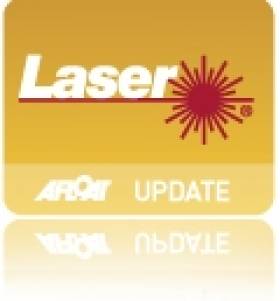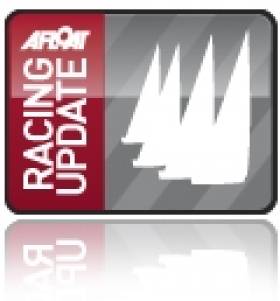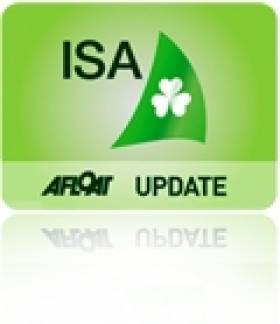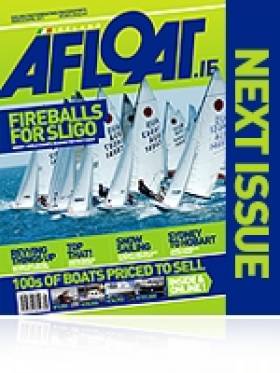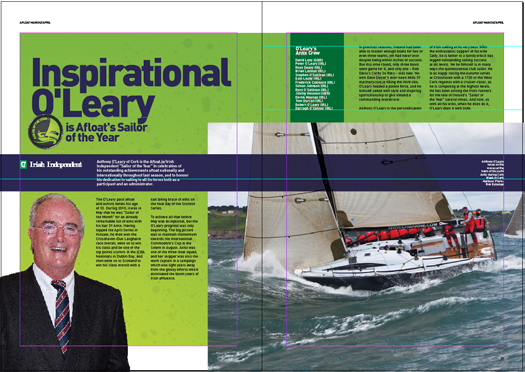Displaying items by tag: Dinghies
UK Laser Sailors in £50K Irish Sea Crossing Challenge
#LASER - A pair of British sailors are set to embark on an intrepid crossing of the Irish Sea using just two single-handed Laser dingies.
David Summerville and Steve Cockerill had originally planned to make the crossing in September last year, but those plans were scuppered by 50-knot gale force winds and a 12-foot tidal swell, according to Incentive Travel.
But the duo is now planning to try again, with the backing of the Ramada Plaza Southport.
“David and Steve will be covering 115 nautical miles during the challenge," said Ramada Plaza general manager Enda Rylands. "They will set off from my own home town of Dublin and finish in Southport, aiming to raise £50,000 for mental health charity Mind and the John Merricks Sailing Trust."
Summerville, a 53-year-old grandfather of two who runs a boat repair business, said the date of the challenge would again depend on weather and tidal conditions, and that the pair is ready to depart any time from mid-April to mid-September.
It's not the first time that an Irish Sea crossing has been done in a Laser as Tiffany Brien achieved the feat in 2010, sailing single-handedly the 30 miles from Portpatrick in Scotland to Belfast Lough.
But Summerville and Cockerill's ambitious undertaking, at more than three times that distance, would surely get them a place in the record books - provided the weather goes their way!
'The Rules of Racing' Lecture in Castlebar This Thursday
#RACING - Mayo Sailing Club's winter series of lectures continues this Thursday 23 February with a talk by Ed Alcock on 'The Rules of Racing'.
Alcock is racing manager of the Irish Sailing Association (ISA), and his lecture will outline the laws that govern racing by windpower on the water in Ireland, covering classes from yachts and dinghies to windsurfing, kitesurfing and more.
Topics to be covered include rights and obligations on the water, giving way, keeping clear, red flags and protest forms.
Sailors of all craft are invited to attend the evening, and anyone wanting to get involved in racing is also welcome, especially with the 2012 racing season only eight weeks away.
Alcock's talk takes place this Thursday at 7.30pm in GMIT Castlebar. The Galway Advertiser has more HERE.
Boat Jumbles for Dun Laoghaire, Howth and Carrickfergus
If you fancy a rummage through a Bosun's locker then boat Jumble sales on three consecutive weekends and at three separate locations will satisfy all bargain hunters when the Irish boating season kicks off in a fortnight's time.
Each show is offering a range of boating, sailing and water sports equipment and accessories. There are new and used pitches and some familiar trade names in addition to second hand boats/dinghies and nautical “car boot” items.
The first opens on March 27th – the weekend when the clocks go forward – and it takes place on the Carlisle Pier in Dun Laoghaire Harbour from 10am to 4pm.
The next is across Dublin Bay when the RNLI stage a boat jumble at Howth Yacht Club on Saturday 2nd April from 10.30am to 1.30pm.
The last show is at Carrickfergus on Belfast Lough and this 'Irish Boat Jumble' is being promoted as the 'biggest' in Ireland. The Antrim show will be on Sunday 10th April starting at 10am.
All are offering economical rates and friends are being encouraged to team up and pool their surplus gear and share the selling task!
Sailing Body Elects First Female President
In one of her last official functions as Minister for Sport, outgoing local TD Mary Hanafin attended the Irish Sailing Association's annual Ball last Saturday in the Royal Marine Hotel in Dun Laoghaire.
Attended by 315 people the black tie ball featured an awards ceremony that has been hailed 'a great success' by the association.
On Saturday afternoon the association elected a new President, Niamh McCutcheon, the first female ISA President since the organisation was founded in 1945.
A collection in aid of the RNLI raised over €2,250.
Award details below:
ISA Sailing Achievement of the Year
This award is presented by the ISA to recognise the outstanding achievement in a sailing craft by an Irish person or in Ireland during 2010.
Winner: Nicholas 'Nin' O'Leary, Royal Cork Yacht Club
Nicholas' achievements included narrowly beating his father Anthony at the ISA All Ireland Championships in 2010 by just a single point after a nail-biting finale in difficult conditions off Kinsale in November. The win made it three-in-a-row for this remarkable young 24 year old sailor - the only person to achieve this in the 64 years of the event's history.
ISA Volunteer of the Year
This award is given to a member of an ISA affiliated club or class who has made a significant voluntary contribution to their sport during 2010.
Winner: Brian Craig, Royal St. George Yacht Club.
Brian has been nominated by the Royal St. George Yacht Club for the vital role he has played in developing sailing in Ireland and specifically Dun Laoghaire over the past 40 years. His most recent success was winning the bid for Dun Laoghaire to host the 2012 ISAF Youth Worlds.
ISA Youth Sailor of the Year
This award is presented by the ISA to recognise the outstanding achievement by a sailor competing in ISA Performance Pathway boats during 2010.
Winner: Finn Lynch, Blessington Sailing Club
Placing 2nd overall at the Topper World Championships in 2010 left the Carlow sailor in good stead for a Youth Sailor nomination. A determined sailor and strong character, it's clear that with these strengths Finn has the potential to go far in our sport.
ISA Instructor of the Year
This award recognises the role instructors have in providing access to our sports. The final 5 have been nominated by their students with the ultimate winner selected by an ISA judging panel.
Winner: Aine Carroll, Rush Sailing Club
Aine has been an ISA instructor for the last 11 years, instructing both adult and junior sailors in Rush Sailing Club. A keen Mermaid sailor, her love of sailing, her enthusiasm for the sport and willingness to give her time to her sailors have been infectious and remarkable. Apparently the kids at the club think she is a 'legend' and 'cool'!
ISA Training Centre of the Year
The face of ISA water sports to thousands of participants. The best in 2010 as nominated by their students.
Winner: University of Limerick Activity Centre
Situated on the sheltered shores of Lough Derg, University of Limerick Activity Centre has been in operation for over a decade. ULAC provides a varied programme of adventure activities to the general public. The University of Limerick Activity Centre runs ISA courses in sailing dinghies, windsurfers, powerboat as well as emergency care training courses.
Afloat's March/April Issue Out Next Week!
Is there no end to the achievements of Irish boaters against seemingly impossible odds?
The winter may have been a time of hibernation for some of us but as the stories in Afloat's March/April issue will bear out Irish sailors have been battling the elements all winter long.
James Carroll competed in January's Sydney-Hobart offshore race and, much closer to home, Paul A. Kay journeyed through snow and ice in December from Dun Laoghaire to a new marina on Valentia Island.
As if to prove a point that we're down but not out, a winter of results on foreign waters includes a win in the Mirror World Championships in Australia and a top Olympic result in Florida, USA.
They are gutsy performances from youth teams that shows, if nothing else, the next generation of Irish sailors is really up for a fight. All this plus lots, lots more on news-stands next week!
Selected contents from Ireland's only boating magazine include:
News
Surveyors Issue Boat Launch Warning, Buoyant Dinghies Buck the Market, Ice Diving in Ireland, German U-Boat Rediscovered in Cork Harbour, an Historic Trophy for South Pacific Dream Cruise, MGM open in Cork, Hugh Mockler joins Crosshaven Boatyard plus lots, lots more.
News Focus
A new masterplan for Dun Laoghaire harbour is badly needed but it needs buy in from all those that use it
Going Offshore
The tenth Dun Laoghaire to Dingle offshore race was launched in style
Marine Conference
Combating the downturn was the focus of a unique marine gathering on both sides of the Irish sea.

Gear Review
New dinghy gear, a new Crosshaven boot from Dubarry, a new raincoat for girls and an upgrade for Musto's MPX.

This Island Nation
The decision to shut down the fog signals was based on a detailed risk assessment. Tom MacSweeney on the loss of fog horns
Sailor of the Year
Anthony O'Leary of Cork is the Afloat.ie/Irish Independent "Sailor of the Year" in celebration of his outstanding achievements afloat nationally and internationally.
Tall Ships
W M Nixon looks at the realities of national sail training in the 21st Century.
Tall Ship Conference
Ireland could yet have a tall ship to replace the Asgard II and the Lord Rank, if a new group formed to press for a replacement is successful
Racing update
Ulstermen's World Title, Topper worlds for Dun Laoghaire, Two Irish campaigns line up for Figaro Race, SB3 Sailors Cry Foul at Dun Laoghaire Parking Fees and an Irish entry in the Moth worlds in Australia, Irish Mini 6.50 Campaign in Prospect.

Youth Worlds preview
Results achieved abroad this Winter are the backbone for further Irish youth
success

Figaro Preview
Two fledgling Irish La Solitaire du Figaro campaigns edged closer to the start line last month
Volvo Dun Laoghaire Regatta
Volvo Dun Laoghaire regatta has taken in 22 entries six months ahead of the first race of the biggest regatta in Irish sailing.
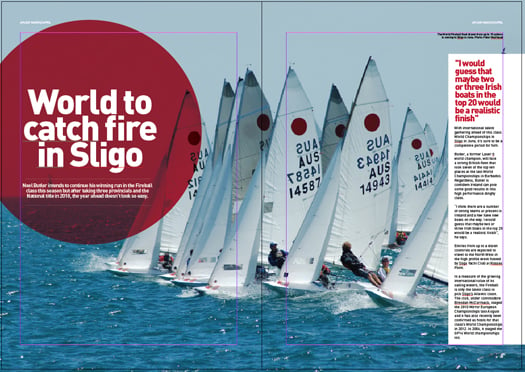
Fireball Worlds preview
Dun Laoghaire's Noel Butler intends to continue his winning run in the Fireball class this season but the year ahead doesn't look so easy as the World Championships come to Sligo
Sovereigns cup preview
Up to 30 Quarter tonners will be at the Sovereigns Cup this year including one from New Zealand.
Shiver to deliver
A journey through snow and ice from Dun Laoghaire to Valentia Island
Sydney-Hobart Race
Outside of the Volvo Ocean Race, the Sydney Hobart is one of the world's most challenging offshore races. James Carroll Raced it in January.
Inland
As the cuts begin to bite, it may be time to look at the British direction for our waterways, writes Brian J Goggin
Dubarry Nautical Crossword
Soundings
A Google aerial photo proves useful navigating for Baldoyle Estuary
- Anthony O'Leary
- Dun Laoghaire
- Tom MacSweeney
- Harbour
- MGM Boats
- Asgard II
- World Championships
- Dinghies
- Olympic
- Cork Harbour
- Valentia
- Mirror
- Dingle
- youth
- Lord Rank
- Island Nation
- Hugh Mockler
- Dubarry
- Tall ship
- brokerage
- sydneyhobart
- fog horn
- moth
- Mini 6.50
- Uboat
- Fireball worlds
- Sovereigns
- James Carroll
- Paul A. Kay
- Crosshaven Boatyard
- Baldoyle
- MPX
- W M Nixon
Monkstown Bay Sailing Club

Goldie Cronin 'Alta to Starboard To Finish' Trophy Event. Photo: Alan Fleury
Monkstown Bay Sailing Club
Monkstown Bay Sailing Club is located in the picturesque village of Monkstown, which overlooks Monkstown Bay in Cork Harbour.
Dingy league races are generally held within the Bay area, while Cruiser league races extend their reach up river to Passage and out the harbour to Cobh, Whitegate and beyond. Weekend events make full use of the Harbour waters, including races to Blackrock, East Ferry and Ballynacorra, and trips to Whitebay and Crosshaven.
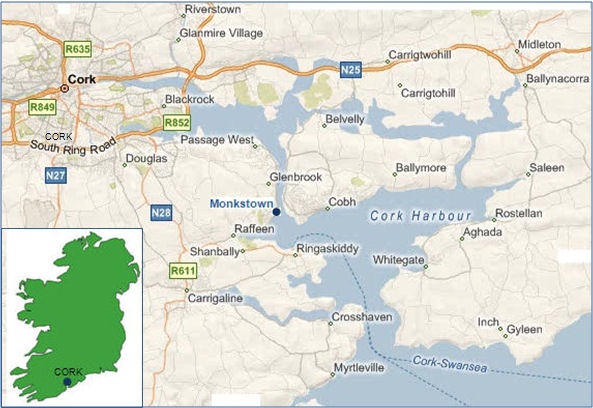
Dinghy sailing club with racing every Tuesday and Friday. All classes welcome. Annual junior training programme run during July. Clubhouse and usual facilities. Membership open. Dinghy courses offered up to Improving Skill, Advanced Boat Handling, and Racing 1.
MBSC Officers and Committee 2009
Commodore – Finian O' Driscoll – Email: [email protected]
Vice-Commodore – John O'Driscoll – Email: [email protected]
Hon. Secretary – Andrew Moynihan – Email: [email protected]
Rear Commodore – Ewen Barry – Email: [email protected]
Hon. Treasurer – John Crotty – Email: [email protected]
Sailing Secretary – Ronan Kenneally – Email: [email protected]
Junior Training Organiser – Ann O'Brien – Email: [email protected]
Monkstown Bay Sailing Club, 3 de Vesci Place, Monkstown, Co. Cork. Tel: 021 485 9935 (Club House) or 087 825 2855 (Alan Fleury), or email: [email protected]
Cullaun Sailing Club
Cullaun Sailing Club
Cullaun Sailing Club is located on the shore of the Lough Cullaunyheeda (Cullaun Lake), in the heart of east Clare. Cullaun Sailing Club is a very active dinghy sailing club, with a fleet comprising mainly of Enterprise, Wayfarer and Laser dinghies. We have six Club boats including three rescue craft (all club events are attended to by Club Rescue craft). We also have two Wayfarer and one Enterprise dinghies (intended for use by members who do not yet have their own craft).
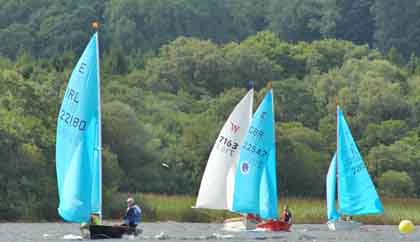
Left: 2006 Regatta at the Club. Photo by Paddy
The Season
Our sailing season extends from March to November and an extensive calendar of events is organised each year. During the summer months sailing is organised twice a week, Tuesday (Beginners\Training Night) and Thursday evenings (Mixed fleet Racing). We also host the Enterprise Inland Championships Regatta, and our own open class regatta. Coastal cruising in chartered keel boats are also organised off the South and West coasts, better kown as 'The September Cruise' have proven to be very popular. We even organise the odd BBQ whenever we get a chance.
Membership
Membership is open to anyone with an interest in sailing. Potential members should contact a Committee Member, who will explain rules and also form a point of contact. Best to visit us on one of our event nights.
(The above information and image courtesy of Cullaun Sailing Club)
Cullaun Sailing Club, c/o Mary Sweeney, Kilkishen, Co Clare. Email: [email protected]
Have we got your club details? Click here to get involved
Irish RS Class Association
New to Ireland, the RS is the fastest growing dinghy fleet in the country. RS's are high performance asymmetric spinnakered dinghies. The 13ft RS200 and the larger 14ft 10in RS400 combine to provide high performance racing for all crew weights and abilities. Class members range from mid teens to mid fifties and compete together. Asymmetrical sailing provides a unique challenge to sailors who want to learn new skills, with tactical fleet racing downwind as well as upwind. The performance will attract the adrenalin junkies!
The RS Class in Ireland
The Irish RS Dinghy Class Association was formed in 2003 to promote the RS class in Ireland. The Association has adopted two dinghies, the RS200 and the RS400 to suit all crew combinations. Both are modern asymmetric spinnakered boats, providing an unparalleled blend of performance, ease of handling and tactical racing.
The RS fleet in Ireland is testiment to both of the dinghy's popularity. With an average growth rate of almost 10 boats per annum, the class is already the leading asymmetric class in the country and rivals most conventional classes in numbers.
The Irish RS National Championship now in its seventh year, forms part of a European circuit with events in the UK, France, Holland, and Italy. The Eurocup event not only attracts International standard racing to local waters but provides an easy avenue for Irish sailors keen to compete abroad.
The Irish RS Association
The Irish RS Dinghy Class Association was set up in 2003 to promote the RS Class in Ireland.
In just a short period of time, the RS class has become the largest asymmetric class in Ireland, with over 40 RS dinghies regularly sailing today. Interest in the class continues to grow as racing asymmetrics dinghies attracts sailors from traditional classes looking for the added tactical challenges and new skills that asymmetrics provide.
The Irish National Championships held annually, form part of the RS European Circuit, drawing competition of the highest calibre from abroad to race in Ireland. For the Irish sailor, this not only brings international racing to home waters, but also presents a ready made international circuit for those who want to race further afield.
Adopting both the RS200 and RS400 dinghies means that sailors of all ages, sizes and abilities are catered for. The RS class currently has sailors ranging from mid teens to mid fifties, both male and female competing against each other.
Irish RS Class Association, c/o Richard Moran, Secretary, 34 Delgany Court, Delgany Park. Tel: 087 234 7157, email: [email protected]
There is a space for Irish boating clubs and racing classes to use as their own bulletin board and forum for announcements and discussion. If you want to see a dedicated forum slot for your club or class, click here
GP14 Class Association of Ireland
GP's have the largest and most active two person senior dinghy racing fleet in Ireland and we can prove it, by counting active boats and fleets. The GP is a one-design 14ft dinghy, raced by a crew of two. It is a three sailed 'mid-performance' boat which can be sailed safely in a wide range of sea and weather conditions, by moderately competent crew or it can be enjoyed while racing on the edge with spinnaker up in force 5 and 6 winds or tactically gaining inches, in a large championship fleet in a flat calm. It is a forgiving boat, easy to learn in and tolerant of a wide range of crew weight or experience.
There are seven national sailing events organised each year by the Class in Ireland. Each month from May to October there is at least one Open Meeting or Championship with attendances varying from 20 to 60 boats, depending on time of year, venue etc. On the water places are hotly contested by crews of the Gold, Silver and Bronze fleets from all around the country and off the water yarns and tips are just as hotly traded and good humored banter is the currency. Anyone who is even a little competitive soon gets hooked on the circuit and quickly makes new friends right across the spectrum of sailors both male and female. The GP14 has been popular here for 40 years and currently has fleets in 17 clubs around the country, where crews of all ages enjoy racing in brand new or older fibreglass or wooden boats costing from €1000 to €12000. The International Class Association keeps the GP14 up to date by continuous development and improvements, carefully designed not to prejudice older boats, while at the same time improving its appeal and ease of maintenance. Cost of ownership is kept down by a special class insurance scheme and restriction on the prices of major items such as sails and spars.
The GP14 Class Association of Ireland
There are about 400 GP's in Ireland with nearly 200 Association members and a strong organisation that looks after their interests with the help of the International Class Association, based in England. Our association provides a lot of help and guidance for members in areas such as Insurance, boat buying, boat tuning, race training, boat building, clubs where GP14s are sailed, World, National and Area Championships and Open Meetings etc.
In Ireland each year there are seven sailing meetings organised around the country including a Junior and Youth Championship, with entries ranging from 30 to 80 boats, most clubs are represented together with frequent visitors from the UK. There is a high standard of competition in the Class in Ireland, which has produced two World Champions and many ISA Champion of Champions and Irish boats regularly feature at the top of British Championships.
The Gp14 Class association of Ireland is organised on a regional basis by a volunteer committee who give of their time to ensure quality racing for all GP14 sailors.
(Above details courtesy of the GP14 Class Association of Ireland)
GP14 Class Association Of Ireland, c/o Tania MacHale, Secretary, Beech Cottage, Dromahair, Co Leitrim. Email: [email protected]
There is a space for Irish boating clubs and racing classes to use as their own bulletin board and forum for announcements and discussion. If you want to see a dedicated forum slot for your club or class, click here
Afloat's Graham Smith wrote, on March 2009: "If 2007 had been a good one for Sligo’s Tim Corcoran and Brendan Brogan, 2008 was even better as the Western crew dominated the GP14 class, winning everything in sight.
They won the Leinsters at Blessington and then the Ulsters at home in Sligo before going on to retain their National Championship title with success at Newtownards. These results saw them win the Traveller’s Trophy and they also won the Speed Sail League, one of the class’s special annual awards.
Gerard Healy won the Youth Championship while Curly Morris headed the Master’s Championship.
Four
new additions brought the national fleet up to 87 this year, with 60 of
them racing regularly at the 17 established GP clubs, while turnouts at
open events averaged the mid-20s. National Champions 2009: Tim Corcoran and
Brendan Brogan, Sligo YC"
Irish Enterprise Class Association
The Enterprise is a 4 metre, two sail sailing dinghy designed by Jack Holt. Its popularity is due to its excellent qualities both as a cruising and a two-man racing boat. The International Enterprise Class Association is based in the UK (also the UK Enterprise Association). There is also an active Irish Enterprise Association. For those who like to race, there is serious competition at both National and International level with some top names in sailing having passed through the class (eg, Shane McCarthy – now a professional sailor, Sean Craig, and Richard Estaugh).
The Enterprise Class is annually represented in the ISA Helmsman’s Championships. There are close to 23,000 registered boats world-wide and about 40 active Irish Enterprise boat owners. The Enterprise is an active and exciting chime-construction boat to sail. It has one mast and two sails (the mainsail and gib). It has neither spinnaker nor trapeze, has plenty of space, is simple in layout and is exceptionally smooth in handling. A large proportion of new boats are glass fibre. Alternatives are the composite boat for those who like wooden decks without the fuss of fitting out a wooden hull.
(Above information courtesy of Enterprise Class)
Contact, Irish Enterprise Class Association, c/o Mr Richard Graves, President, 51 Carysfort Downs, Blackrock, Co Dublin. Email: [email protected], website: www.enterpriseclass.ie (inactive as at 23/9/09)
Afloat's Graham Smith wrote the following in the March 2009 issue: "Once the leading dinghy class in Ireland and the provider of many of Ireland’s leading sailors over a couple of decades, the Enterprise is now a pale shadow of its former self yet still provides close racing for the stalwarts who maintain an interest.
The national fleet has dwindled to around 25 dotted around six or seven clubs, with Bray – one of the pioneers of the class when it was formed 50 years ago – still the major supplier, so it’s no surprise to see Ger Dempsey from the County Wicklow club as the dominant figure in the class.
He won the two regional events – one on home waters and the other at Cullaun – before regaining his national title which Greystones’ Roy Van Maanen had taken the previous year when the event formed part of the Worlds in Dun Laoghaire.
National Champion as at March 2009: Ger Dempsey, Bray SC."
There is a space for Irish boating clubs and racing classes to use as their own bulletin board and forum for announcements and discussion. If you want to see a dedicated forum slot for your club or class, click here


























